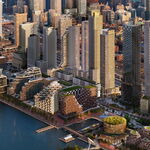DirectionNorth
Senior Member
You have one very important omission: Ottawa calls its RT stations "O-Train station."You are correctly naming the culprit for the unfortunate naming of the LRT station serving VIA Rail's Ottawa station (and much more serious misjudgments), but it's certainly not VIA's fault for not having renamed the station to fit within Ottawa's rigid LRT station naming conventions. Cities all over the world have coped with name-less train stations when naming their LRT stations. Ottawa is the notable exception by nothing else than choice.
You only have to look at Montreal to see what happens if you let non-experts and politicians design transportation infrastructure and networks, with a new combined highway-and-rail bridge built for many billions (but with specifications so flimsy which preclude most heavy rail applications) and a tunnel which has been converted from open heavy rail standard to a closed Light Metro system (just at the very moment where a High Speed Rail project was planned which would suffer near-fatal blows to its business case if it couldn't use that tunnel). Similarly, Ottawa instead on choosing the one LRT consortium which failed to achieve "the minimum technical score to qualify for the project" at its own peril...
Let's just stick to "train station" and urban rail networks Canada (from East-to-West):
The STM calls its subway service "Métro" (i.e., not a "train" service) and its stops "Stations" (i.e., not a "train station"):
The REM calls its service "light rail transit" and its stops "REM stations":
The TTC calls its subway services "Subway Lines" and its stops "Stations" or "Stops" and its streetcar services "Streetcar Lines" and their stops "stops":
Edmonton calls its LRT service "LRT" and its stops "LRT stations":
Calgary calls its LRT service "CTrain" and its stops "CTrain stations":
Finally, Translink calls Vancouver's Light Metro network "SkyTrain" and its stops "SkyTrain Stations":
As we can see with these seven urban rail networks across Canada, no Canadian city refers to any of its urban rail networks as a "train" service and their stops as "train stations".
Conversely, there actually is one rail service in this country, which does call its services a "train" service and their stops "train stations":
Therefore, the claim that naming any of Ottawa's LRT stations "Train Station" would have been confusing for any Canadian resident appears to me as a fabricated claim to somehow excuse the bizarre refusal of the City of Ottawa and its transit operator OC Transpo to name its LRT station at Tremblay Road after the only train station which serves the actual city (as opposed to Fallowfield station which serves its Barrhaven suburb). And just to be sure, there are many valid alternatives to "Train Station", such as calling it "VIA Rail Station", "VIA Rail" or even "Tremblay (VIA Rail Station)"...
Personally, I like the O-Train branding, and it makes sense given the separate modes the OLRT uses.
Of the 8/15 cities, only Ottawa and Kitchener have sort-of intercity/rapid transit interfaces, and Kitchener calls their station "Kitchener Central," but a central location is not one Ottawa is often accused of.My understanding is that "train station" is a North American term, whereas "rail station" is used in the rest of the anglosphere (and beyond):
Not sure what exactly your definition of "major city" is, but if we have a look at the main train stations in those CMA cities which have more than 300,000 inhabitants, the main rail station of only seven out of these 15 cities have a name attached:
City Main train station Specific Station Name Toronto Toronto Union Station Union Station Montreal Montreal Gare Centrale Gare Centrale Vancouver Vancouver Pacific Central Pacific Central Ottawa-Gatineau Ottawa train station none Calgary no passenger rail service none Edmonton Edmonton train station none Quebec City Quebec Gare du Palais Gare du Palais Winnipeg Winnipeg train station (according to VIA)
Winnipeg Union StationUnion Station Hamilton Hamilton GO Centre GO Centre Kitchener-Cambridge-Waterloo Kitchener train station none London London train station none Halifax Halifax train station none St. Catharine's-Niagara St. Catharine's train station none Windsor Windsor train station none Oshawa Oshawa train station (according to VIA)
Durham College Oshawa (according to GO Transit)Station name sponsorship by nearby university (not acknowledged by VIA Rail)
That would still be easier to navigate for visitors unfamiliar with the city than "Tremblay"...
"Ottawa-Tremblay" is my preference, as "Ottawa Station" only makes sense in a downtown location, and "Train Station" is redundant with the system's name. ("Rail Station" is just silly)












